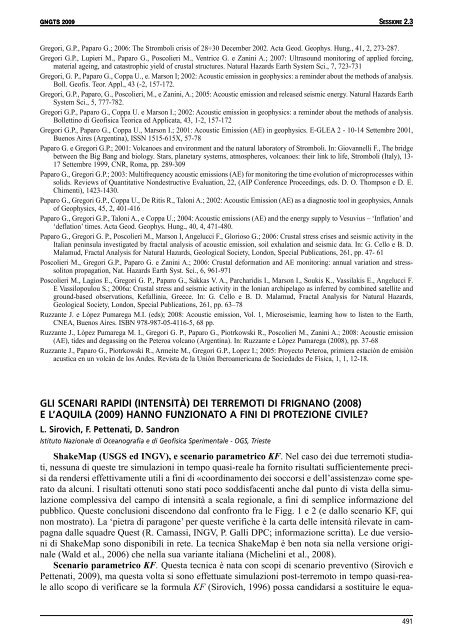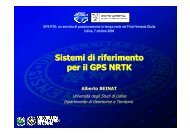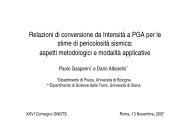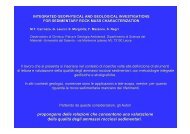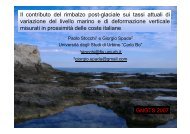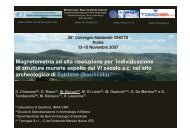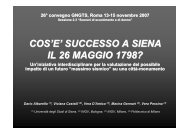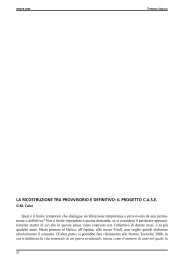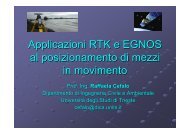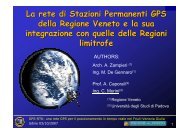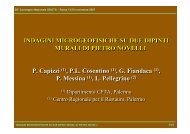You also want an ePaper? Increase the reach of your titles
YUMPU automatically turns print PDFs into web optimized ePapers that Google loves.
GNGTS 2009 SESSIONE <strong>2.3</strong><br />
Gregori, G.P., Paparo G.; 2006: The Stromboli crisis of 28÷30 December 2002. Acta Geod. Geophys. Hung., 41, 2, 273-287.<br />
Gregori G.P., Lupieri M., Paparo G., Poscolieri M., Ventrice G. e Zanini A.; 2007: Ultrasound monitoring of applied forcing,<br />
material ageing, and catastrophic yield of crustal structures. Natural Hazards Earth System Sci., 7, 723-731<br />
Gregori, G. P., Paparo G., Coppa U., e. Marson I; 2002: Acoustic emission in geophysics: a reminder about the methods of analysis.<br />
Boll. Geofis. Teor. Appl., 43 (-2, 157-172.<br />
Gregori, G.P., Paparo, G., Poscolieri, M., e Zanini, A.; 2005: Acoustic emission and released seismic energy. Natural Hazards Earth<br />
System Sci., 5, 777-782.<br />
Gregori G.P., Paparo G., Coppa U. e Marson I.; 2002: Acoustic emission in geophysics: a reminder about the methods of analysis.<br />
Bollettino di Geofisica Teorica ed Applicata, 43, 1-2, 157-172<br />
Gregori G.P., Paparo G., Coppa U., Marson I.; 2001: Acoustic Emission (AE) in geophysics. E-GLEA 2 - 10-14 Settembre 2001,<br />
Buenos Aires (Argentina), ISSN 1515-615X, 57-78<br />
Paparo G. e Gregori G.P.; 2001: Volcanoes and environment and the natural laboratory of Stromboli. In: Giovannelli F., The bridge<br />
between the Big Bang and biology. Stars, planetary systems, atmospheres, volcanoes: their link to life, Stromboli (Italy), 13-<br />
17 Settembre 1999, CNR, Roma, pp. 289-309<br />
Paparo G., Gregori G.P.; 2003: Multifrequency acoustic emissions (AE) for monitoring the time evolution of microprocesses within<br />
solids. Reviews of Quantitative Nondestructive Evaluation, 22, (AIP Conference Proceedings, eds. D. O. Thompson e D. E.<br />
Chimenti), 1423-1430.<br />
Paparo G., Gregori G.P., Coppa U., De Ritis R., Taloni A.; 2002: Acoustic Emission (AE) as a diagnostic tool in geophysics, Annals<br />
of Geophysics, 45, 2, 401-416<br />
Paparo G., Gregori G.P., Taloni A., e Coppa U.; 2004: Acoustic emissions (AE) and the energy supply to Vesuvius – ‘Inflation’ and<br />
‘deflation’ times. Acta Geod. Geophys. Hung., 40, 4, 471-480.<br />
Paparo G., Gregori G. P., Poscolieri M., Marson I, Angelucci F., Glorioso G.; 2006: Crustal stress crises and seismic activity in the<br />
Italian peninsula investigated by fractal analysis of acoustic emission, soil exhalation and seismic data. In: G. Cello e B. D.<br />
Malamud, Fractal Analysis for Natural Hazards, Geological Society, London, Special Publications, 261, pp. 47- 61<br />
Poscolieri M., Gregori G.P., Paparo G. e Zanini A.; 2006: Crustal deformation and AE monitoring: annual variation and stresssoliton<br />
propagation, Nat. Hazards Earth Syst. Sci., 6, 961-971<br />
Poscolieri M., Lagios E., Gregori G. P., Paparo G., Sakkas V. A., Parcharidis I., Marson I., Soukis K., Vassilakis E., Angelucci F.<br />
E Vassilopoulou S.; 2006a: Crustal stress and seismic activity in the Ionian archipelago as inferred by combined satellite and<br />
ground-based observations, Kefallinia, Greece. In: G. Cello e B. D. Malamud, Fractal Analysis for Natural Hazards,<br />
Geological Society, London, Special Publications, 261, pp. 63–78<br />
Ruzzante J. e Lòpez Pumarega M.I. (eds); 2008: Acoustic emission, Vol. 1, Microseismic, learning how to listen to the Earth,<br />
CNEA, Buenos Aires. ISBN 978-987-05-4116-5, 68 pp.<br />
Ruzzante J., Lòpez Pumarega M. I., Gregori G. P., Paparo G., Piotrkowski R., Poscolieri M., Zanini A.; 2008: Acoustic emission<br />
(AE), tides and degassing on the Peteroa volcano (Argentina). In: Ruzzante e Lòpez Pumarega (2008), pp. 37-68<br />
Ruzzante J., Paparo G., Piotrkowski R., Armeite M., Gregori G.P., Lopez I.; 2005: Proyecto Peteroa, primiera estaciòn de emisiòn<br />
acustica en un volcàn de los Andes. Revista de la Uniòn Iberoamericana de Sociedades de Fìsica, 1, 1, 12-18.<br />
GLI SCENARI RAPIDI (INTENSITÀ) DEI TERREMOTI DI FRIGNANO (2008)<br />
E L’AQUILA (2009) HANNO FUNZIONATO A FINI DI PROTEZIONE CIVILE<br />
L. Sirovich, F. Pettenati, D. Sandron<br />
Istituto Nazionale di Oceanografia e di Geofisica Sperimentale - OGS, Trieste<br />
ShakeMap (USGS ed INGV), e scenario parametrico KF. Nel caso dei due terremoti studiati,<br />
nessuna di queste tre simulazioni in tempo quasi-reale ha fornito risultati sufficientemente precisi<br />
da rendersi effettivamente utili a fini di «coordinamento dei soccorsi e dell’assistenza» come sperato<br />
da alcuni. I risultati ottenuti sono stati poco soddisfacenti anche dal punto di vista della simulazione<br />
complessiva del campo di intensità a scala regionale, a fini di semplice informazione del<br />
pubblico. Queste conclusioni discendono dal confronto fra le Figg. 1 e 2 (e dallo scenario KF, qui<br />
non mostrato). La ‘pietra di paragone’ per queste verifiche è la carta delle intensità rilevate in campagna<br />
dalle squadre Quest (R. Camassi, INGV, P. Galli DPC; informazione scritta). Le due versioni<br />
di ShakeMap sono disponibili in rete. La tecnica ShakeMap è ben nota sia nella versione originale<br />
(Wald et al., 2006) che nella sua variante italiana (Michelini et al., 2008).<br />
Scenario parametrico KF. Questa tecnica è nata con scopi di scenario preventivo (Sirovich e<br />
Pettenati, 2009), ma questa volta si sono effettuate simulazioni post-terremoto in tempo quasi-reale<br />
allo scopo di verificare se la formula KF (Sirovich, 1996) possa candidarsi a sostituire le equa-<br />
491


